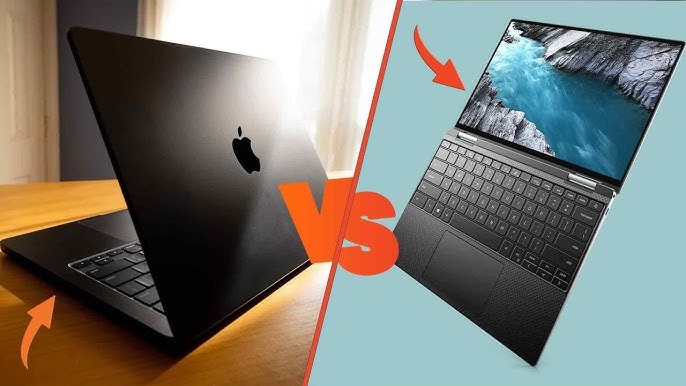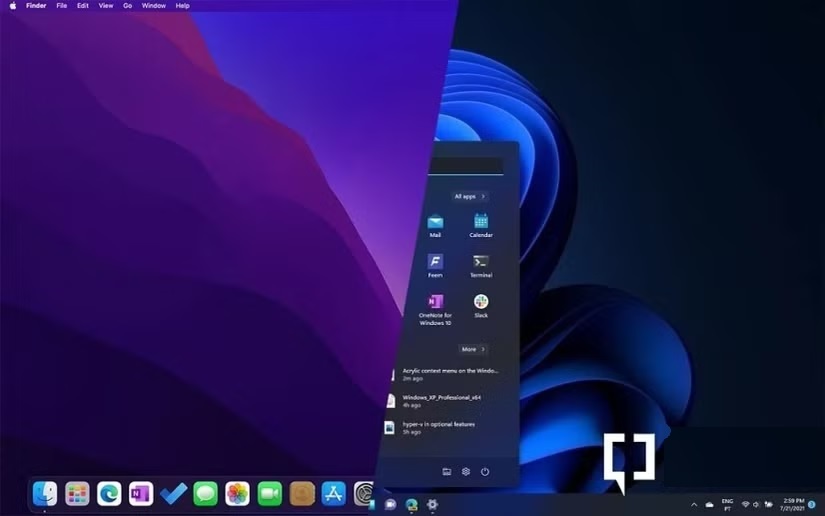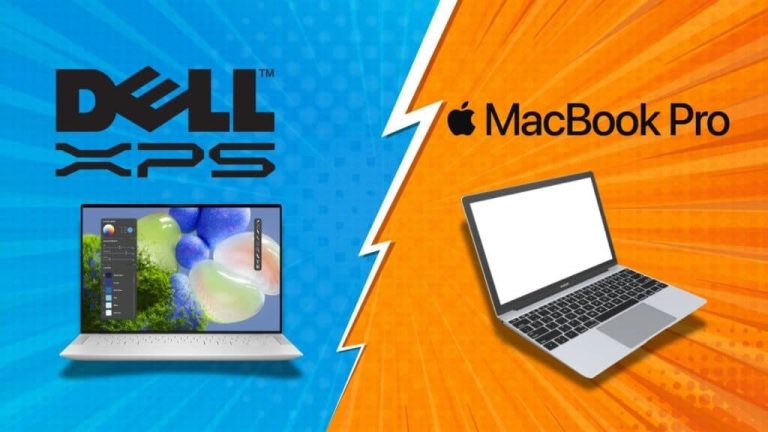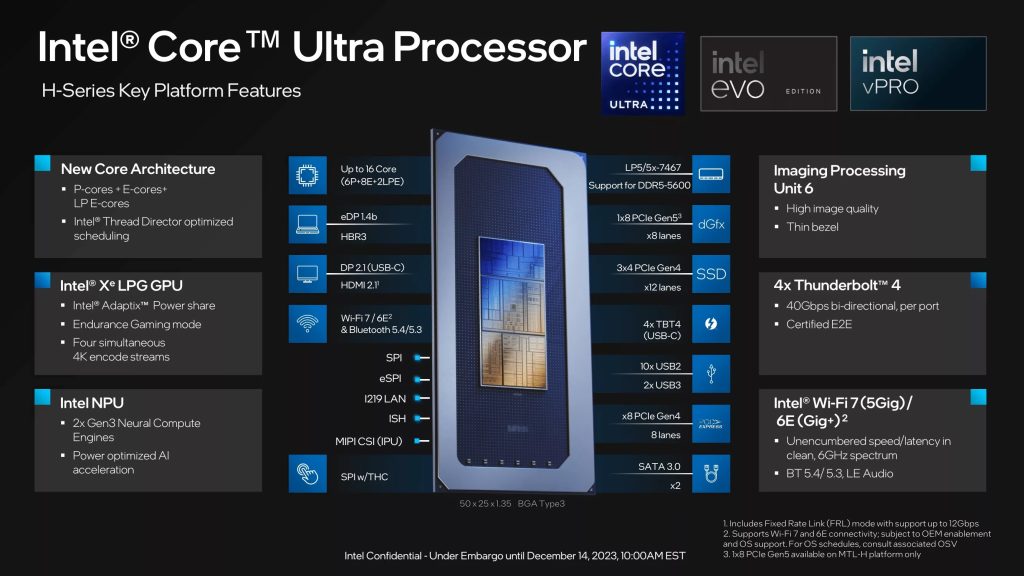If 2024 was the warm-up round, 2025 is where things get serious in the productivity laptop arena. On one side, Apple flexes its muscles with the MacBook Pro 2025 powered by the next-gen Apple M5 chip, promising blazing speed and longer battery life. On the other, Dell counters with its redesigned Dell XPS lineup, including the ultra-sleek XPS 13 Plus and the powerhouse XPS 16 2025, both running on Intel’s latest Core Ultra processors and AI-optimized performance.
The real question is no longer about macOS versus Windows – it’s about who delivers the smoother, faster, and smarter productivity experience. Whether you’re editing 4K video, coding a new app, or juggling 30 browser tabs, both brands are fighting for your workflow’s crown.
Apple’s pitch is simple: seamless performance, whisper-quiet operation, and marathon-level MacBook Pro battery life. Dell’s counterpunch? A Windows laptop that blends futuristic design, touch innovation, and sheer multitasking muscle.
In this deep-dive, we’ll compare everything that matters-from chip performance and display brilliance to design durability and AI-powered features. By the end, you’ll know which laptop deserves a spot on your desk (and maybe a chunk of your savings).

Design and build quality
Apple and Dell have always played in the same league when it comes to design, but their philosophies couldn’t be more different. The MacBook Pro 2025 continues Apple’s tradition of precision engineering and minimalist elegance. It’s carved from a single block of recycled aluminum, giving it a sturdy yet lightweight feel that’s both premium and practical. The slight refinement in the chassis this year makes it a touch thinner, while new space black and silver finishes add a luxurious edge.
The Dell XPS series, meanwhile, has evolved into a design icon of its own. The Dell XPS 13 Plus keeps its futuristic edge with a nearly invisible touch function row and edge-to-edge keyboard. The Dell XPS 16 2025 takes it up a notch with a larger display and carbon fiber palm rests that make long typing sessions comfortable. Dell’s InfinityEdge display still leads the way for ultra-thin bezels, creating a more immersive workspace that feels bigger than its footprint.
While Apple’s design leans on subtle sophistication, Dell’s aesthetic screams innovation. One focuses on refinement, the other on reinvention. In day-to-day use, both feel robust, portable, and durable, but there’s a slight difference in vibe. The MacBook Pro feels like a precision tool, while the XPS feels like a concept car turned real.
When it comes to ports, Apple has listened-finally. The 2025 model keeps the HDMI and SD card slot while offering three Thunderbolt 5 ports for future-proof connectivity. Dell, not to be outdone, packs in USB-C ports with Thunderbolt 4 support, and while some users miss the classic USB-A, Dell’s compact adapter in the box softens the blow.
Verdict: Apple edges out in polish and materials, but Dell wins on futuristic flair and screen-to-body ratio. Your choice here depends on whether you prefer timeless craftsmanship or a bold, tech-forward look.

Display and visual experience
If you spend your days staring at a laptop screen, you know that display quality isn’t just about pretty pixels – it defines how enjoyable and productive your workday feels. Both Apple and Dell understand this deeply, and their 2025 models show it.
The MacBook Pro 2025 continues using Apple’s stunning Liquid Retina XDR display, now slightly improved with higher peak brightness and better HDR contrast. It supports ProMotion with adaptive refresh rates up to 120Hz, making scrolling and video playback silky smooth. Whether you’re editing high-resolution photos or watching Netflix between Zoom calls, the colors remain vivid, accurate, and balanced. Apple’s color calibration still sets the gold standard for creative professionals who rely on consistent tones.
On the other side, the Dell XPS 16 2025 offers an OLED 4K touch display option that’s nothing short of cinematic. Blacks are truly black, and colors pop with an intensity that can make Apple’s screen feel slightly conservative. For those who love touch gestures, Dell’s inclusion of a touchscreen is a win, especially since macOS still avoids touch support. The Dell XPS 13 Plus also brings a stunning 3.5K OLED option, offering deep contrasts and impressive sharpness in a smaller form factor.
In everyday use, the MacBook’s display feels more color-true and less reflective, perfect for bright offices and editing sessions under harsh lighting. Dell’s OLED panels, on the other hand, are a treat for movie lovers, designers, and multitaskers who appreciate rich tones and interactive control.
When comparing screen real estate, the 16-inch XPS obviously delivers more workspace than the 14-inch MacBook Pro, though Apple’s optimized macOS scaling makes even the smaller display feel spacious. Both support wide color gamuts and HDR content, so whether you’re creating or consuming, visuals look breathtakingly crisp.
Verdict: If you crave color accuracy and smooth performance, the MacBook Pro 2025 wins. If you love OLED vibrancy and touch flexibility, the Dell XPS series steals the spotlight.

Performance and hardware
The 2025 laptop battle is no longer about who has the better logo on the lid – it’s all about the silicon inside. Apple’s M5 chip and Dell’s latest Intel Core Ultra processors bring two distinct philosophies to performance, both pushing the boundaries of what a productivity laptop can do.
Let’s start with Apple’s new brain. The MacBook Pro 2025 powered by the Apple M5 chip continues Apple’s march toward total hardware-software harmony. Built on a refined 3-nanometer architecture, it offers up to 20 percent faster CPU performance and an impressive 30 percent graphics boost over the previous M3 generation. The chip’s unified memory architecture still gives macOS an edge in efficiency – everything from exporting 8K video to crunching large code projects feels seamless and cool to the touch. Apple’s Neural Engine also gets a major AI bump this year, enabling faster image generation, real-time background removal in video calls, and smarter app optimizations.

The result? Blistering performance with whisper-quiet thermals. Even during long rendering or multitasking sessions, the MacBook Pro remains calm and collected. Battery drain is minimal, making it ideal for creators and developers who live unplugged for hours.
On the other side of the arena, Dell’s XPS 16 2025 and XPS 13 Plus embrace Intel’s latest Core Ultra 9 and Ultra 7 chips. These CPUs mark a new era for Windows laptops – combining traditional performance cores with neural processing units (NPUs) built for AI tasks. The XPS can handle multitasking with incredible ease, running virtual machines, creative apps, and AI-assisted tools without breaking a sweat. Paired with up to 64GB of LPDDR5x RAM and Nvidia RTX 4070 graphics (for the 16-inch model), Dell’s machines can handle everything from video editing to light gaming.
One area where Apple’s M5 architecture still dominates is sustained performance per watt. The efficiency cores make macOS operations feel instantaneous while sipping power. Dell, meanwhile, offers more raw horsepower and flexibility – especially for those who prefer Windows customization, gaming, or GPU-heavy workloads.
Thermal performance also differs. Apple’s cooling system remains almost silent under pressure, while Dell’s fans can get audible during extended 3D rendering or AI model training sessions. However, Dell’s larger chassis helps dissipate heat effectively, preventing major throttling.
Verdict: Apple’s M5 chip performance shines for pure efficiency and consistent speed, while Dell’s Core Ultra lineup offers raw versatility and better GPU options. In real-world use, the MacBook Pro feels smoother for daily productivity, while the Dell XPS 16 leads in heavy creative and AI workloads.
Battery life and portability
Battery life is where productivity dreams are made or broken. After all, no one wants to be tethered to a wall outlet halfway through a project or meeting. In 2025, both Apple and Dell have pushed the limits of endurance, but once again, their approaches couldn’t be more different.
The MacBook Pro 2025 continues Apple’s reign as the marathon runner of laptops. Thanks to the incredible efficiency of the Apple M5 chip, the 14-inch model delivers up to 20 hours of battery life on light-to-moderate tasks, while the 16-inch version comfortably hits 18 hours even with creative workloads. Whether you’re editing photos, streaming, or managing spreadsheets, the battery drain feels almost mythical. It’s the kind of device you can carry from morning coffee to midnight deadlines without thinking about a charger.
Apple also fine-tuned its power management through macOS 15. The new system dynamically adjusts performance cores based on task intensity, ensuring maximum endurance without throttling responsiveness. Add in fast charging support that gives you 50 percent battery in 30 minutes, and the MacBook remains the travel-friendly choice for frequent flyers and remote workers.
Now, the Dell XPS 16 2025 and XPS 13 Plus also make big strides. With Intel’s Core Ultra chips and AI-driven battery optimization, Dell claims up to 13 hours of runtime on the 13 Plus and around 11 on the 16-inch model with OLED display. While those numbers don’t rival Apple’s record, they’re still impressive given the higher resolution touch screens and discrete graphics. Dell’s ExpressCharge feature is another perk, delivering roughly 80 percent in under an hour – great for quick power boosts between meetings.
When it comes to portability, the MacBook Pro 14 remains the sweet spot, balancing weight and power perfectly. The 16-inch version, though slightly heavier, feels solid and evenly balanced. Dell’s XPS 13 Plus, being ultra-slim and under 1.3 kg, is the most portable of the bunch – ideal for those who value mobility over maximum power. The XPS 16, while larger, fits into the same travel-friendly premium segment as the MacBook Pro 16.
Verdict: Apple wins for endurance and battery consistency, while Dell fights back with faster charging and lighter travel options. If longevity matters most, the MacBook Pro 2025 remains the undisputed battery life champion.

Software experience and ecosystem
Hardware may win headlines, but software decides how a laptop feels day to day. In 2025, both Apple and Dell double down on creating seamless, intelligent ecosystems – though the experiences couldn’t be more different.
The MacBook Pro 2025 runs on macOS 15, a polished and increasingly AI-infused system that’s all about efficiency and continuity. Everything just flows. The interface feels clean, transitions are buttery smooth, and integration with other Apple devices remains unmatched. Need to answer a FaceTime call from your iPhone, drag a file from your iPad, or copy text to your Mac? It happens instantly. Apple’s ecosystem continues to reward users who are fully invested in its world, and with iCloud improvements, syncing files across devices is faster and more reliable than ever.
This year, macOS also brings deeper AI integration – from voice-enhanced Spotlight searches to auto-summarizing notes and intelligent window management. Combined with the Apple M5 chip performance, it creates an environment that feels intuitive and almost predictive of your workflow. Apps open instantly, updates are quiet and quick, and the system rarely stutters even under heavy multitasking.
The Dell XPS lineup, running Windows 12, delivers a different kind of power. Windows has matured into a smart, productivity-focused OS with heavy AI integration through Copilot, Microsoft’s built-in assistant. Tasks like scheduling, document creation, and web research can be automated or assisted directly within your workflow. Dell complements this with its own utilities like MyDell, which optimizes power, performance, and display settings automatically based on usage.
What’s impressive is how flexible the Windows environment has become. If you love customization, the XPS gives you freedom to tweak, modify, and control every detail – from appearance to performance. It’s an open playground compared to Apple’s tightly curated garden. And for professionals using specialized apps or gaming occasionally, Windows still has the upper hand in compatibility.
Verdict: macOS 15 offers unmatched harmony and stability for those deep in the Apple ecosystem, while Windows 12 on the XPS delivers flexibility and AI-rich productivity for power users. Choosing between them depends on whether you prefer structure or freedom – Apple’s curated smoothness or Dell’s customizable canvas.

Price, value, and overall verdict
With both laptops packing serious performance and premium design, price becomes the final deciding factor for most buyers. In 2025, the line between power and practicality is thinner than ever, and both Apple and Dell are asking you to pay top dollar for top-tier experiences.
The MacBook Pro 2025 starts at around $1,999 for the 14-inch model with the base M5 chip and 16GB unified memory. The 16-inch version, configured with the M5 Pro or M5 Max, easily crosses $3,000, especially if you max out storage and RAM. These prices place it firmly in the professional segment – photographers, developers, and video editors who value efficiency, longevity, and stability over bargain hunting. Still, Apple’s resale value and unmatched battery life help justify the cost over time. You’re essentially paying for a five-year-plus investment that will run cool and fast without aging badly.
Dell’s XPS 13 Plus and XPS 16 2025, on the other hand, hit a wider range of budgets. The XPS 13 Plus begins around $1,399, with high-end OLED configurations topping out near $2,000. The larger XPS 16 starts at roughly $1,799 and can reach $2,999 when configured with an Intel Core Ultra 9 and RTX 4070 GPU. In essence, Dell gives you more configuration freedom – from a stylish ultrabook for travel to a powerhouse workstation for creators.
Where Dell wins is flexibility. You can tailor the XPS lineup to fit your workflow, whether that’s light productivity, media creation, or even gaming. However, Apple wins in polish. The MacBook Pro feels more cohesive out of the box, thanks to its tight integration between hardware and macOS. There are no driver updates to chase, no fan curve adjustments to tweak – just instant, refined performance.
In terms of value, if you’re looking for the best productivity laptop 2025, the MacBook Pro 2025 still takes the crown for professionals who prioritize endurance, efficiency, and build quality. But if you crave touch capability, customization, and a slightly lower entry price, the Dell XPS series might be your smarter bet.
Both machines are kings in their own kingdoms. The MacBook vs Windows laptops debate will continue, but in 2025, the competition has never been this close. Choosing between them is less about performance gaps and more about personality – the sleek, serene confidence of the MacBook Pro, or the bold, futuristic ambition of the Dell XPS.
Verdict: For creators and coders seeking longevity and flawless performance, go MacBook Pro 2025. For multitaskers, tinkerers, and touch-screen fans who love flexibility, the Dell XPS lineup reigns supreme in the Windows world.
FAQs: MacBook Pro 2025 vs Dell XPS
- Which is better for productivity, the MacBook Pro 2025 or Dell XPS 2025?
Both are productivity champions, but in different ways. The MacBook Pro 2025 delivers unmatched efficiency, battery life, and smooth multitasking thanks to the Apple M5 chip. The Dell XPS lineup, powered by Intel Core Ultra processors, offers greater customization, touchscreen options, and GPU power. If you’re a professional editor or developer, go for the MacBook Pro. If you need flexibility and Windows compatibility, Dell wins. - How does the Apple M5 chip performance compare to Intel’s Core Ultra?
The Apple M5 chip leads in efficiency, thermal control, and sustained performance, making the MacBook Pro incredibly fast and power-efficient. Intel’s Core Ultra processors, featured in Dell’s latest XPS models, are more versatile and include dedicated AI cores, offering an edge in AI-enhanced tasks and gaming performance. - What about MacBook Pro battery life vs Dell XPS battery life?
The MacBook Pro 2025 still dominates here. Expect around 18–20 hours of real-world use, while the Dell XPS 13 Plus and XPS 16 2025 average between 11 and 13 hours depending on configuration. Dell compensates with faster charging and lighter designs, but Apple remains the endurance leader. - Is the Dell XPS 13 Plus good for professionals?
Yes, the Dell XPS 13 Plus is ideal for professionals who value portability, style, and a premium screen. It’s not as powerful as the MacBook Pro M5 or XPS 16 for heavy creative work, but it’s perfect for writers, designers, and office users who prioritize compact performance and modern design. - Which laptop offers better value for money in 2025?
The MacBook Pro 2025 offers long-term value through consistent performance, longevity, and high resale potential. The Dell XPS provides better short-term flexibility, lower starting prices, and diverse configurations. Your choice depends on whether you want a premium all-in-one experience or modular control over your hardware. - Should I choose MacBook vs Windows laptops for 2025?
If you’re already in the Apple ecosystem and need reliability, go MacBook. If you want a customizable, touch-capable device that integrates with Windows tools and AI features, Dell’s XPS range offers exceptional versatility.


